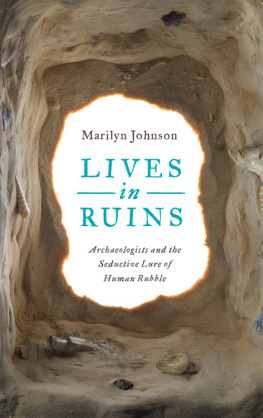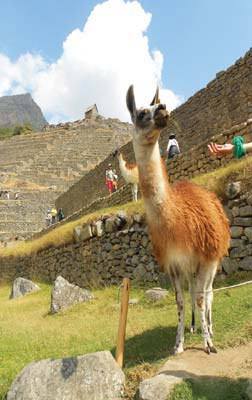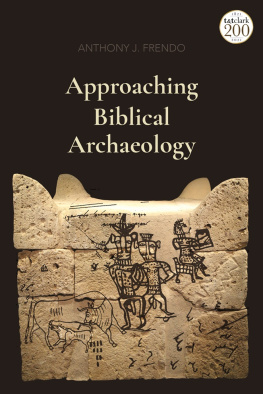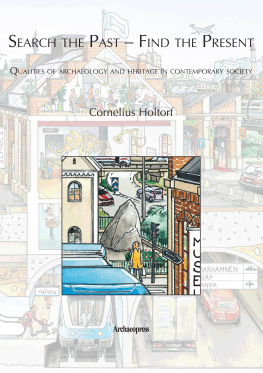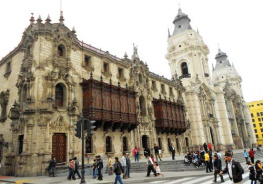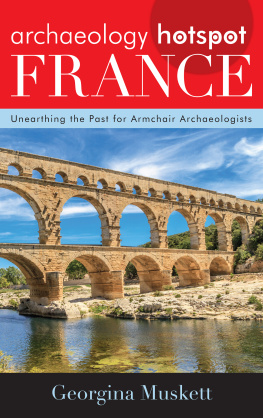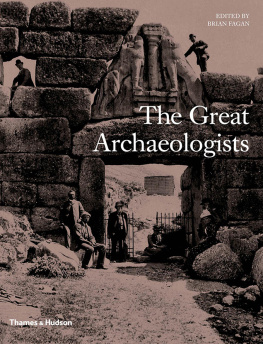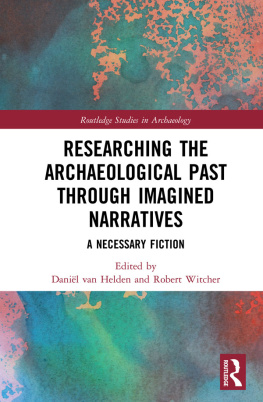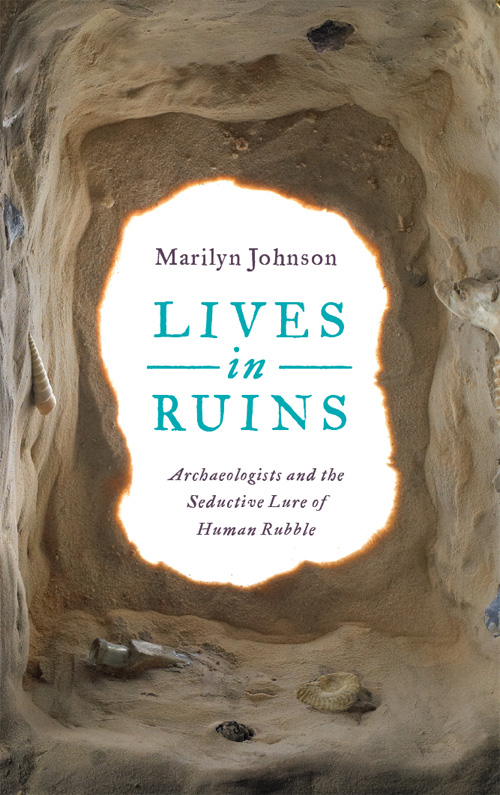To Rob
This has become the archaeologists grandiose task: to make dried-up wellsprings bubble forth again, to make the forgotten known again, the dead alive, and to cause to flow once more that historic stream in which we are all encompassed....
C . W . CERAM ,
Gods, Graves, and Scholars: The Story of Archaeology
Contents

N O DINOSAURS appear in these pages. If you are looking for scientists who study dinosaurs, you want to pick up a book about paleontologists. This book is about archaeologists, people who study people and the things that they leave behindtheir bones, their trash, and their ruins.
The archaeologists in this book work with humble stuff, from stone tools and broken pots to dirt. They are expert in the way things fall apart and acute observers of context; the placement and surroundings of an object can make the difference between junk and intellectual gold. To the archaeologist, treasure is something that was buried that has been brought to light, a pebble of information around which the narrative of history now needs to bend. I think of the archaeologist I saw on a loop of video, a young woman up to her hips in a muddy tunnel that would soon be a subway station in New York City, her eyes sparkling under a construction hat: We found a coin with a date on it!
There is no better time than now to follow archaeologists; new finds and scientific advances keep revising what we know. The bones of a British king turn up in a parking lot. Bronze Age shoes and Viking mittens pop up in ice melts. Lidar, an aerial mapping tool, reveals a vast and ancient city beneath Angkor Wat. Recurring headlines read: ( PICK A PLACE ) OCCUPIED ( EONS ) EARLIER THAN PREVIOUSLY BELIEVED . Technological advances account for some of archaeologys boom, but war, commercial development, violent weather, and warming temperatureschange and destructionare doing their part to lay bare the layers of the past. The world is mutating faster than archaeologists can keep up.
Yet, as their sites multiply and their profession expands, archaeologists find themselves in the same predicament as other cultural memory workers: with too little support for the hard work of salvaging and making sense of our past. How much progress can they hope to make when their goal is to capture history before it disappears forever? We think we know what archaeologists do, but, like librarians, they toil behind an obscuring stereotype. The Hollywood image of the dashing adventurer bears little resemblance to the real people who, armed with not much more than a trowel and a sense of humor, try to tease one true thing from the rot and rubble of the past.
I assumed that everyone in the sandbox wanted to grow up to become an archaeologist. I spent my childhood digging with garden tools, hypnotically absorbed in the hunt for fossils; part of the appeal in researching this book was the prospect of returning to the ground and learning to sift and scrutinize with fresh eyes. I really wanted to see the earth through archaeologists eyes. What do they observe in a pile of ruins? How does a shard of pottery or an ancient tooth help them piece together the past? How can they help us recapture and preserve our history?
I chased the real thing for this book, up to the summit of Machu Picchu and down to the chilly waters of Newport, Rhode Island. I became a keen collector of archaeologists and a connoisseur of their skills. I sought experts on different eras who specialize in a variety of artifacts. I hunted for archaeologists in places that dont ordinarily attract archaeological attention: the Caribbean and the weedy edge of Fishkill, New York, where archaeologists piece together history, post-Columbus, from plantations and graves. I found my way to a classical-era excavation in the Mediterranean with a group of earth-whisperers, and got a taste of Old World archaeology from the Bronze Age to the fall of Rome. I studied ancient humans and followed an archaeologist whose passion is the Ice Age. I followed archaeologists who work with the military, with homicide cops, and with brewers. I met archaeologists from Peru, Japan, Australia, the U.K., Germany, the Netherlands, Israel, and Zimbabwe. I found as many female sources as male ones in this once male-dominated field.
I sweated and excavated alongside my guides; they tossed out most of what I found. In turn, I exercised my own prerogative as a writer and tossed out all the chaff, jargon, measurements, calibrated radiocarbon dates, and theories that seemed too needlessly technical for nonscientists, or that failed to illuminate the essential character of The Archaeologist. What does it take to spend your life scratching into the surface of this planet? Why does it matterand, by the way, how much beer is involved? Such is the nature of my quest.
One graduate student told me, When the Apocalypse comes, you want to know an archaeologist, because we know how to make fire, catch food, and create hill forts, and I promptly added her to my address book. Knows how to make hill fortswho can say when that will come in handy? Of course, she continued, referring to the long-term employment prospects for her and her classmates, we will end up living in cardboard boxes, just as our parents fear. Archaeological fieldwork is messy, usually short-term work for hire assessing land for imminent development, to certify that this skyscraper or that pipeline or strip mall wont destroy an ancient village or a sacred burial ground. Those who persevere in the profession fight like cats to get these jobs and work like dogs to keep them. And for all their expertise, competence, breadth of experience, and even cockiness, they are continually humbled by their subject. For people who know so much, there is so much they can never know. One archaeologist said, with a shrug, Someone will find most of my first book all wrong; and another said of his students, What theyll know in ten years will put us to shame. I was drawn to those with experience, long-term perspective, scars, and storiesthe toughest I could find.
FOUR YEARS AGO I stood in the National Museum of IrelandArchaeology in Dublin, contemplating vast quantities of ancient gold objects churned up by the bogs of Ireland: hammered collars, big gold balls, gold diadems and bracelets and things to stick in your ears (they think). At the time, the Irish economy was tanking. Dublin was running, as far as I could tell, on what spilled out of the pockets of Brits during their bachelor parties. And yet here was all this gold, artifacts floating in display cases like jewelry from Brobdingnag.
Behind the main room of the museum, tucked out of sight and discreetly concealed from casual view, was another sort of archaeological bounty surrendered by the bogs: a cache of human bodies, hundreds and sometimes thousands of years old, strangely preserved by the oxygen-deprived bog waters: Instead of the flesh decaying to leave skeletons, the bones of these bog bodies dissolved, leaving behind flesh, organs, and even hairnatural mummies. A snip of the soundtrack from a looping video was audible. We can look into the face of an Iron Age man! the voice exulted. He still has eyelashes! Each bog body was displayed in a separate chamber that you walked into as if entering the giant shell of a snail; the bodies rested inside the carpeted walls, where a dignified hush prevailed. I stopped to stare at Clonycavan Man, a little skinny guy with a wispy goatee and a face shriveled to dark leather. His hair was piled atop his head like a prom queens, pomaded with an ointment made from ingredients produced by a tree that grew only near the Mediterranean, more than a thousand miles away from where he lived and died.

